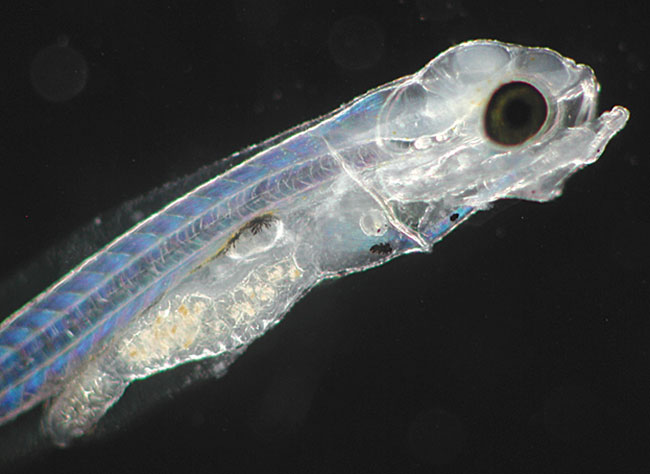
News & Views
Fish Health
Fish Nutrition
Research
Less rotifer time maximizes growth in hybrid striped bass larva: study
May 8, 2020 By Ruby Gonzalez
 Hybrid striped bass larva
(Credit: Dr. Adam Fuller)
Hybrid striped bass larva
(Credit: Dr. Adam Fuller) Minimizing the time hybrid striped bass (HSB) Morone chrysops x M. saxatilis larva are fed with rotifers could lead to several plus factors, including slashing feed expenses in one phase by almost 90 percent.
The results of a study by Dr. Adam Fuller and his team demonstrate that minimizing the time larvae were fed rotifers maximized growth. It also showed that Artemia is a suitable diet for six-day-old larval HSB and that these larvae can easily be weaned from rotifers at both optimum and sub-optimum culture temperature, at 26°C and 18°C, respectively, while maintaining suitable growth and with no significant drop in survival.
Despite their commercial importance, one factor limiting the growth of the HSB industry is the lack of refined methods to rear larvae in tanks, including the lack of knowledge on optimal rearing conditions, feeding behavior, and efforts to reduce the time larvae spend utilizing live foods.
“Reducing the time live feeds are needed greatly reduces risk and costs, which makes it advantageous to determine the earliest time the larvae can be weaned from live feed to an alternative, ideally a manufactured feed. Artemia cysts are readily available, much easier to culture, require less infrastructure, and the nauplii can serve as a first or transition food for a number of fishes, including many Morone spp.,” Fuller told Hatchery International.
Fuller is a research geneticist at the Harry K. Dupree Stuttgart National Aquaculture Research Center in Arkansas.
“While Artemia is much less time-consuming and costly than the production of rotifers, it is still much more expensive than a manufactured feed. Due to these enormous costs associated with live feeds, minimizing or eliminating just the rotifer portion of hybrid striped bass production could reduce production costs in a tank-based system by up to 89 percent,” Fuller pointed out.
At the end of the study, larvae from the 18°C system were shorter by almost 1.6mm than those reared in the 26°C, which measured 9.59mm. Total length and body depth of larvae varied significantly among treatments by temperature, the number of days they were fed rotifers, and the interaction of temperature and the days they were fed rotifers.
“These results demonstrate that minimizing time larvae were fed rotifers maximized growth,” the authors of the study stated.
According to the study, two days was the minimum amount of time that the larva could be fed and have maximum growth.
“And, actually, the longer you fed the larva before offering a larger food item, the slower they grew. So it does seem like HSB larva do require a minimum amount of time spent on very small live feed, in this case two days of rotifers, while they develop larger mouths that are capable of consuming bigger food items.
“However, continuing to feed this smaller live feed for any longer than this minimum time seems to be a detriment to their growth,” the study said.
Print this page
Advertisement
- Oyster hatchery deploys automated feeding system
- U.S. moves to propel aquaculture with new executive order





